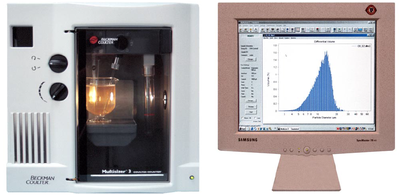Multisizer 3 (Beckmann Coulter Counter)
With the Multisizer 3 the size distribution of dispersed particles is numerically determined by counting the particles up to 100 µm with the electrical sensing zone technique.
The Electrical Sensing Zone (ESZ) technique ,also known as the Coulter Principle, is a technique that allows particles, homogeneously suspended in a conducting liquid, to be simultaneously counted and sized.
Analytical instruments based on the Coulter Principle often serve as references in the evaluation of other particle size analyzers or sizing techniques due their high resolution.
In the ESZ method a suspension is made to flow through a small cylindrical opening (the aperture) separating two electrodes between which an electric current flows. As each particle passes through the aperture (or “sensing zone”) it displaces its own volume of conducting liquid, momentarily increasing the impedance of the aperture. This increase of impedance is directly proportional to the volume of the particle that produced it. Scaling these pulse heights in volume units enables a size spectrum. In addition, if a metering apparatus is used to draw a known volume of the suspension through the aperture, a count of the number of pulses will yield the concentration of particles per unit volume in the suspension.
